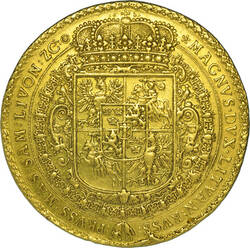This is the heaviest gold coin in our collection. It weighs precisely 348.37 grammes. The coin has been in the Dresden Münzkabinett's collection since 1680, when it was first mentioned in the collection's earliest gold inventory.
No wonder it was never put into circulation. It was too heavy. Instead, it was issued to be presented as an award or a gift. King Sigismund the Third Vasa had it minted to commemorate an important military event. In 1621, the Polish army won a victory at Khotyn over the forces of the Ottoman ruler, Sultan Osman the Second. It was the first time since the sea battle of Lepanto in 1571 that a Christian army had managed to defeat the Ottoman troops. All of Europe celebrated the success. Pope Gregory the Fifteenth even ordered a celebration of thanksgiving that lasted for several days.
On the coin's obverse, we see Sigismund the Third, King of Poland and Grand Duke of Lithuania – with a fine lace collar, richly decorated armour, and the chain of the order of the Golden Fleece. It's quite magnificent. The reverse shows the coats of arms of the Polish-Lithuanian Commonwealth, Sweden and the Vasa family.
The large, hundred-ducat gold coin was struck at the Polish mint in Bromberg (present-day Bydgoszcz). At the time, it was being run by the royal administrator Jakob Jakobson van Emden. The dies were cut by the medallist Samuel Ammon from Danzig, now Gdansk in Poland.
Further Media
- Location & Dating
- 1621
- Material & Technique
- Gold, embossed, edge with hallmark 100
- Dimenions
- Diameter: 68,8 mm; weight: 348,369 g
- Museum
- Münzkabinett
- Inventory number
- AUA3005
